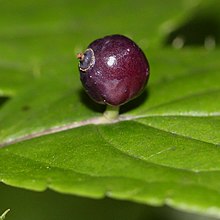Helwingia
| Helwingia | |
|---|---|

| |
| Flowering Helwingia japonica var. japonica specimen | |

| |
| Detail of epiphyllous Helwingia japonica fruit | |
| Scientific classification | |
| Kingdom: | Plantae |
| Clade: | Tracheophytes |
| Clade: | Angiosperms |
| Clade: | Eudicots |
| Clade: | Asterids |
| Order: | Aquifoliales |
| Family: | Helwingiaceae Decne.[1] |
| Genus: | Helwingia Willd. |

| |
| Distribution of Helwingia | |
The genus Helwingia consists of shrubs or rarely small trees native to eastern Asia, the Himalayas, and northern Indochina. It is the only genus in the family Helwingiaceae.[2][3]
Description
[edit]The plants have alternate, evergreen or deciduous leaves and small inflorescences that are epiphyllous (growing from the leaf surface). During development, the flowers appear separate from the leaves,[further explanation needed], eventually fusing with the leaf midrib.[4] Flowers are small and yellow-green or purple, followed by red or black berries. Plants are dioecious.[5]
Epiphyllous inflorescences
[edit]This trait is rather unusual among plants. This atypical floral position upon a leaf is believed to be an adaption to insect pollination. Pollinators which are too large to be supported by the floral pedicels, land on the leaf surface and can pollinate the flowers, which would not be able to support the pollinators on their own.[6]
Taxonomy
[edit]The APG II classification (2003) places them in the order Aquifoliales, along with the hollies and Phyllonomaceae, which also has epiphyllous flowers.[7]
The family Helwingiaceae does not exist in the Cronquist classification (1981), which places this genus in the Cornaceae (dogwood family). Helwingia has also previously been placed in the Araliaceae (ginseng family).[8]
The family is named for botanist Georg Andreas Helwing.[9]
Species
[edit]Species adapted from the World Checklist of Selected Plant Families:[2]
- Helwingia chinensis Batalin - Thailand, Myanmar, China: Gansu, Guizhou, Hubei, Hunan, Shaanxi, Sichuan, Tibet, Yunnan
- Helwingia himalaica Hook.f. & Thomson ex C.B.Clarke - Thailand, Myanmar, Bhutan, Nepal, India: Assam, Sikkim, China: Tibet, Chongqing, Guangdong, Guangxi, Guizhou, Hubei, Hunan, Sichuan, Yunnan
- Helwingia japonica (Thunb.) F.Dietr. - Japan (incl. Ryukyu Islands), Korea, Taiwan, Myanmar, Bhutan, Vietnam, India: Assam, Sikkim, China: Anhui, Fujian, Gansu, Guangdong, Guangxi, Guizhou, Henan, Hubei, Hunan, Jiangsu, Jiangxi, Shaanxi, Shandong, Shanxi, Sichuan, Yunnan, Zhejiang
- Helwingia omeiensis (W.P.Fang) H.Hara & S.Kuros. - China: Gansu, Guangxi, Guizhou, Hubei, Hunan, Shaanxi, Sichuan, Yunnan
References
[edit]- ^ Angiosperm Phylogeny Group (2009). "An update of the Angiosperm Phylogeny Group classification for the orders and families of flowering plants: APG III". Botanical Journal of the Linnean Society. 161 (2): 105–121. doi:10.1111/j.1095-8339.2009.00996.x. hdl:10654/18083.
- ^ a b Kew World Checklist of Selected Plant Families[permanent dead link]
- ^ Flora of China Vol. 14 Page 227 青荚叶属 qing jia ye shu Helwingia Willdenow, Sp. Pl. 4: 634, 716. 1806, nom. cons., not Helvingia Adanson (1763).
- ^ Dickinson, Timothy A.; Sattler, Rolf (1975). "Development of the Epiphyllous Inflorescence of Helwingia japonica (Helwingiaceae)". American Journal of Botany. 62 (9): 962–973. doi:10.2307/2441641. ISSN 0002-9122. JSTOR 2441641.
- ^ Sun, Cheng; Yu, Guoliang; Bao, Manzhu; Zheng, Bo; Ning, Guogui (2014). "Biological pattern and transcriptomic exploration and phylogenetic analysis in the odd floral architecture tree: Helwingia willd". BMC Research Notes. 7: 402. doi:10.1186/1756-0500-7-402. PMC 4083144. PMID 24969969.
- ^ Sun, Cheng; Yu, Guoliang; Bao, Manzhu; Zheng, Bo; Ning, Guogui (2014). "Biological pattern and transcriptomic exploration and phylogenetic analysis in the odd floral architecture tree: Helwingia willd". BMC Research Notes. 7: 402. doi:10.1186/1756-0500-7-402. PMC 4083144. PMID 24969969.
- ^ Dickinson, T. A.; Sattler, R. (1974). "Development of the epiphyllous inflorescence of Phyllonoma integerrima (Turcz.) Loes.: implications for comparative morphology*". Botanical Journal of the Linnean Society. 69 (1): 1–13. doi:10.1111/j.1095-8339.1974.tb01609.x. ISSN 1095-8339.
- ^ Hara, Hiroshi; Kurosawa, Sachiko (1975). Ohashi, H. (ed.). "A Revision of the Genus Helwingia". Flora of the Eastern Himalayas. 3: 393–413.
- ^ Hinkley, Daniel J. (1 May 2007). "Helwingia". Horticulture Magazine.
External links
[edit]- Aquifoliales - Angiosperm Phylogeny Website, consulted 2007-01-26.
- Helwingiaceae Archived 2006-11-01 at the Wayback Machine, Watson, L., and Dallwitz, M.J. 1992 onwards. The families of flowering plants: descriptions, illustrations, identification, and information retrieval. Version: 29 July 2006.
- Also see Cornaceae Archived 2007-03-10 at the Wayback Machine
- Helwingiaceae from NCBI-Taxonomy
- Helwingiaceae, USDA, ARS, National Genetic Resources Program. Germplasm Resources Information Network - (GRIN Online Database). National Germplasm Resources Laboratory, Beltsville, Maryland. Consulted 2007-01-26.
